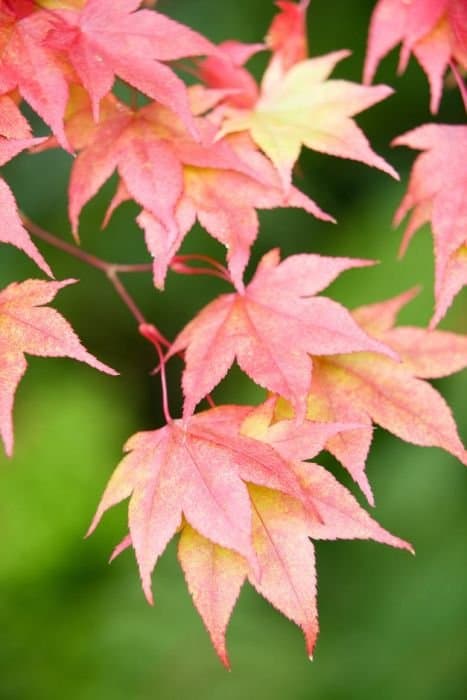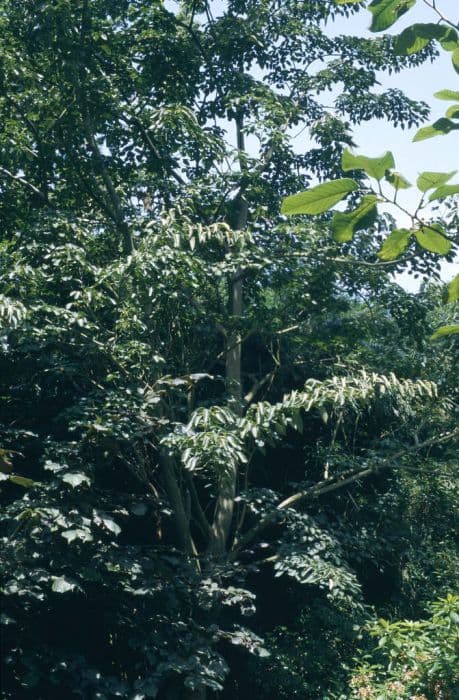Bigleaf maple Acer macrophyllum

ABOUT
The Acer macrophyllum, more widely known as the Bigleaf Maple, is a deciduous tree renowned for its large, striking leaves. The leaves are the most distinctive characteristic, usually with five lobes and measuring much broader than those of other maples—indeed, among the largest of any maple. Each leaf is palmate, meaning that it resembles an open hand with fingers spreading out from the palm. They have a rich green color on the top surface, while the underside is a more muted shade. In the fall, these leaves provide a dramatic display as they shift to vibrant hues of yellow, orange, or sometimes even a deep red before they drop. The bark of the Bigleaf Maple is gray or brown and can develop a rough, ridged texture as the tree matures. Its flowers are also noteworthy; they appear in the spring as small, yellow to greenish-yellow clusters, which stand out against the foliage. The blossoms give way to winged fruit called samaras, which are typical of this genus. These helicopter-like seeds can be seen twirling to the ground as they are dispersed by the wind. During the blooming season, the Bigleaf Maple also sports attractive, pendulous flower clusters that can add to its ornamental appeal. While the main visual allure remains the broad leaves that can measure quite impressive in size, the plant's overall appearance boasts a lush, dense canopy, which is a marvel in landscapes during the growing season.
About this plant
 Names
NamesFamily
Sapindaceae
Synonyms
Bigleaf Maple, Oregon Maple, Pacific Maple, Broadleaf Maple, Largeleaf Maple, White Maple
Common names
Acer macrophyllum Pursh, Acer macrophyllum var. texanum Pax, Acer macrophyllum var. fruticosum Pax, Acer texanum (Pax) Small, Acer oreganum Nutt., Acer denticulatum Hook. & Arn.
 Toxicity
ToxicityTo humans
The Bigleaf maple is not commonly known to be toxic to humans. There are no well-documented cases of poisoning from ingesting parts of this tree. Therefore, there are no specific symptoms of poisoning associated with the Bigleaf maple for humans. However, as with any plant, individual allergic reactions or sensitivities could potentially occur.
To pets
The Bigleaf maple is generally not considered toxic to pets. There is no significant evidence that suggests common domestic animals, such as dogs and cats, would be poisoned by ingesting parts of this tree. Consequently, there are no specific symptoms associated with Bigleaf maple poisoning in pets. It is always best to prevent pets from ingesting plants as individual animals may have sensitivities or allergic reactions.
 Characteristics
CharacteristicsLife cycle
Perennials
Foliage type
Deciduous
Color of leaves
Green
Flower color
Greenish-yellow
Height
50 feet (15.24 meters)
Spread
40 feet (12.19 meters)
Plant type
Tree
Hardiness zones
5
Native area
North America
Benefits
 General Benefits
General Benefits- Shade Provider: Acer macrophyllum, commonly known as Bigleaf Maple, offers ample shade with its large leaves and broad canopy.
- Ecosystem Support: It serves as a habitat for various wildlife species, including birds and small mammals.
- Ornamental Value: Its impressive size and vibrant fall colors make it popular in landscape design and as a street tree.
- Soil Stabilization: The extensive root system helps prevent soil erosion and maintains slope stability.
- Water Cycle Contribution: As a large deciduous tree, it plays a role in water cycling and helps maintain regional humidity levels.
- Wood Production: The Bigleaf Maple provides valuable timber that is used in furniture making and woodcraft.
- Recreational Use: The sap can be tapped to make maple syrup, making it a resource for hobbyists and small-scale syrup producers.
- Carbon Sequestration: By growing large and living long, it captures and stores carbon dioxide, helping to mitigate climate change.
 Medical Properties
Medical Properties- Wound healing: Traditionally, the bark of the Bigleaf maple has been used by indigenous peoples as a poultice for wounds.
- Eye wash: Infusions made from the leaves have been used to soothe sore eyes.
- Diarrhea and dysentery management: The bark has been used in folk remedies to help reduce diarrhea and dysentery symptoms.
- Antifungal activity: Extracts from the Bigleaf maple have been studied for antifungal properties against certain pathogens.
 Air-purifying Qualities
Air-purifying QualitiesThis plant is not specifically known for air purifying qualities.
 Other Uses
Other Uses- The bigleaf maple's wood is often used for making musical instruments such as guitars and violins due to its acoustic properties.
- Its bark can be processed to create a dark brown dye that is used in traditional textile crafts.
- Furniture makers value the wood of bigleaf maples for its grain and workability in crafting high-quality furniture.
- Wood from the bigleaf maple is also suitable for smoking food, giving it a mild, sweet flavor.
- The fiber from its wood pulp can be used in the paper-making process for producing sturdy paper products.
- The sap can be tapped much like that of its eastern relative, the sugar maple, although it has a lower sugar content.
- Its large leaves are sometimes employed in decorative arts, for example, as natural stencils for painting or as molds for clay pottery.
- The tree's winged fruits, known as samaras, may be used in educational settings to illustrate principles of wind dispersal for seeds.
- Bigleaf maple leaves are occasionally used as feed for farm animals like horses or cows, particularly in times of fodder scarcity.
- Its attractive fall foliage makes it a sought-after species for ornamental landscaping and urban forestry.
Interesting Facts
 Feng Shui
Feng ShuiThe Bigleaf Maple is not used in Feng Shui practice.
 Zodiac Sign Compitability
Zodiac Sign CompitabilityThe Bigleaf Maple is not used in astrology practice.
 Plant Symbolism
Plant Symbolism- Strength and Endurance: The Acer macrophyllum, commonly known as the Bigleaf Maple, demonstrates strength and endurance by its ability to grow into a large and sturdy tree, capable of withstanding harsh conditions.
- Growth and Longevity: As a tree that can live for several hundred years, the Bigleaf Maple represents the concept of growth over time and longevity, symbolizing the potential for a long and productive life.
- Adaptability: The Bigleaf Maple is adaptable to different environments, which is why it is often seen as a symbol of the ability to thrive in various conditions and situations.
- Prosperity: In some cultures, the maple tree is associated with prosperity and abundance, possibly because of its ample foliage and the value of its strong wood.
- Generosity: With its broad leaves that shed in the fall, the Bigleaf Maple is sometimes associated with generosity, providing abundant compost material that enriches the soil.
 Water
WaterThe Bigleaf Maple should be watered deeply once a week during dry periods without significant rainfall, providing it with approximately 1.5 inches of water each time to ensure the soil is moist but not saturated. During the growing season in spring and summer, it may require more frequent watering, especially if planted in well-draining soil or during periods of drought. Adjust watering during the fall and consider winter watering only if the soil is dry and the tree is not dormant. It's key to allow the soil to dry out slightly between watering sessions to prevent root rot.
 Light
LightBigleaf Maples thrive best in full sun to partial shade. The ideal spot for planting a Bigleaf Maple would have exposure to morning sunlight and some shade in the afternoon, especially in areas with hot summers. These trees can adapt to a range of light conditions but may develop more vibrant fall color with a bit more exposure to sunlight.
 Temperature
TemperatureBigleaf Maples are hardy and can withstand a minimum temperature of around -10°F, but they grow best in areas where the average temperature ranges from 70°F to 80°F. They can survive up to maximum temperatures around 100°F, as long as they are provided with sufficient water during hot spells. The ideal temperature conditions for Bigleaf Maples would be a temperate climate with moderate to cool temperatures throughout the year.
 Pruning
PruningPrune the Bigleaf Maple to remove any damaged, diseased, or crossing branches to maintain tree health and structure. Pruning is best done in late winter or early spring before the sap starts to flow. These trees generally require little pruning, but shaping them can improve their appearance and health of the tree. Always use clean, sharp tools to make clean cuts.
 Cleaning
CleaningAs needed
 Soil
SoilThe Bigleaf Maple prefers well-draining soil rich in organic matter. A mix with equal parts loamy soil, peat, and coarse sand can provide suitable drainage and nutrients. The preferred soil pH for Bigleaf Maple is slightly acidic to neutral, ranging between 5.5 and 7.0.
 Repotting
RepottingBigleaf Maples, being large trees, are not typically repotted once established. Young saplings may be repotted every two to three years until they are planted outdoors.
 Humidity & Misting
Humidity & MistingBigleaf Maple thrives in moderate to high humidity environments, typical of its native woodland habitats. It is important to maintain at least 50% relative humidity around the plant for optimal growth.
 Suitable locations
Suitable locationsIndoor
It's impractical to grow Bigleaf Maples indoors due to their size.
Outdoor
Plant in moist, well-drained soil; full sun to partial shade.
Hardiness zone
5-9 USDA
 Life cycle
Life cycleBigleaf maple (Acer macrophyllum) begins its life cycle from a seed, which after dispersal, often by wind due to its wing-like samara, germinates when in contact with moist soil in a suitable environment. The seedling emerges and develops into a juvenile plant, characterized by rapid growth and the development of essential structures like leaves and roots. As the tree matures, it enters a vegetative state where growth continues and it develops a thick woody trunk, as well as extensive branches and foliage. After reaching maturity, which can take several years, the bigleaf maple begins its reproductive phase, producing flowers that are pollinated by insects. Following pollination, the flowers develop into the characteristic winged samaras, which are then released into the environment to start a new generation. Throughout its life, the bigleaf maple will go through repeated cycles of growth, reproduction, and dormancy, typically marked by seasonal changes.
 Propogation
PropogationPropogation time
Spring-early summer
Propogation: The most popular method of propagating the Bigleaf Maple, scientifically known as Acer macrophyllum, involves the use of its seeds. For successful propagation, the seeds are best sown as soon as they are ripe in a cold frame. This usually occurs in the fall, directly following seed maturation. Once sown, the seeds require a period of cold stratification, which can be naturally provided by the winter temperatures. Cold stratification is crucial because it simulates the natural winter conditions the seeds need to break dormancy and promotes successful germination in the spring. After the stratification period, the seedlings can be carefully transplanted into individual pots and grown on in colder conditions until they are ready to be planted in their final positions. This is typically done when they are large enough to handle, often after the second leaf has developed.








